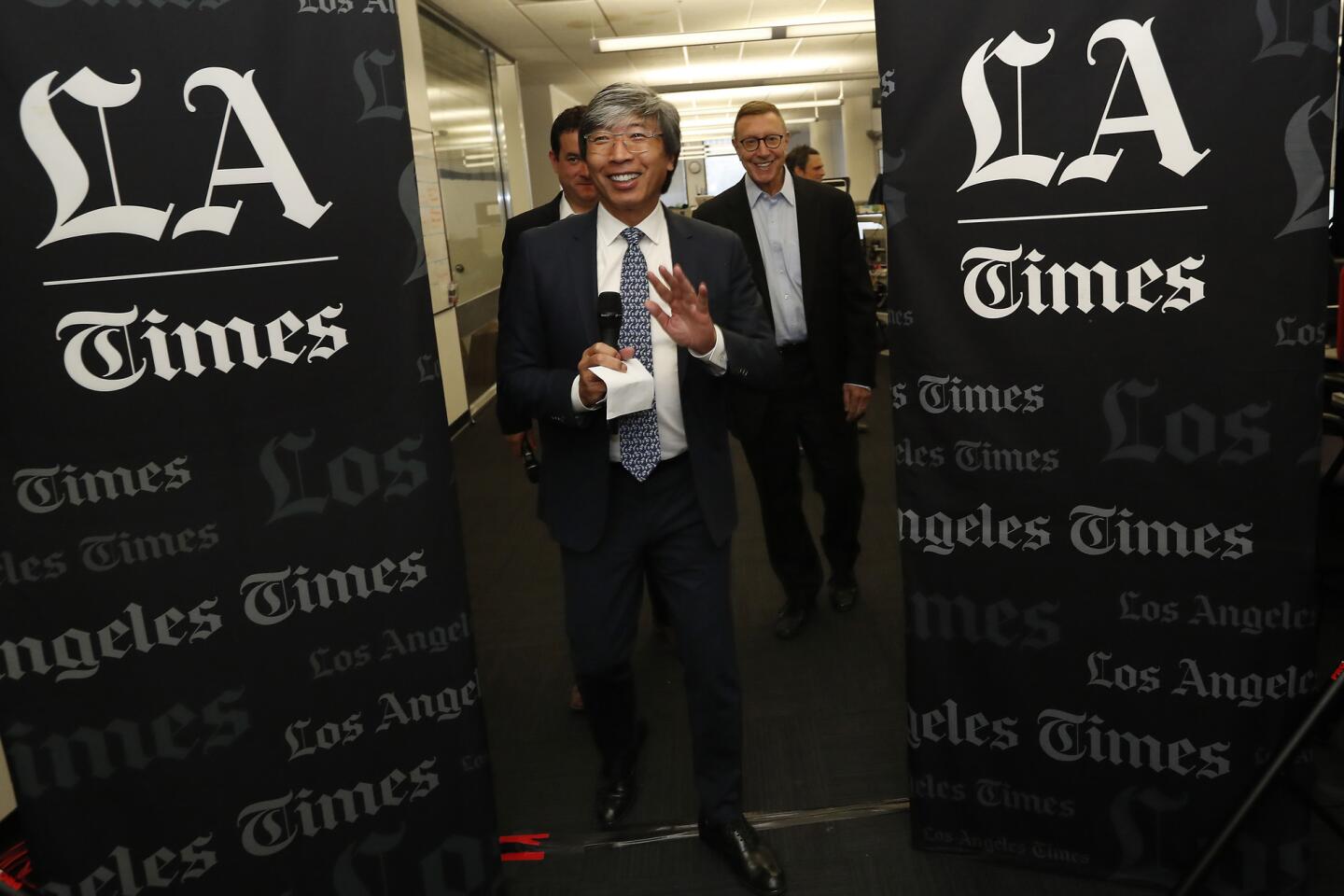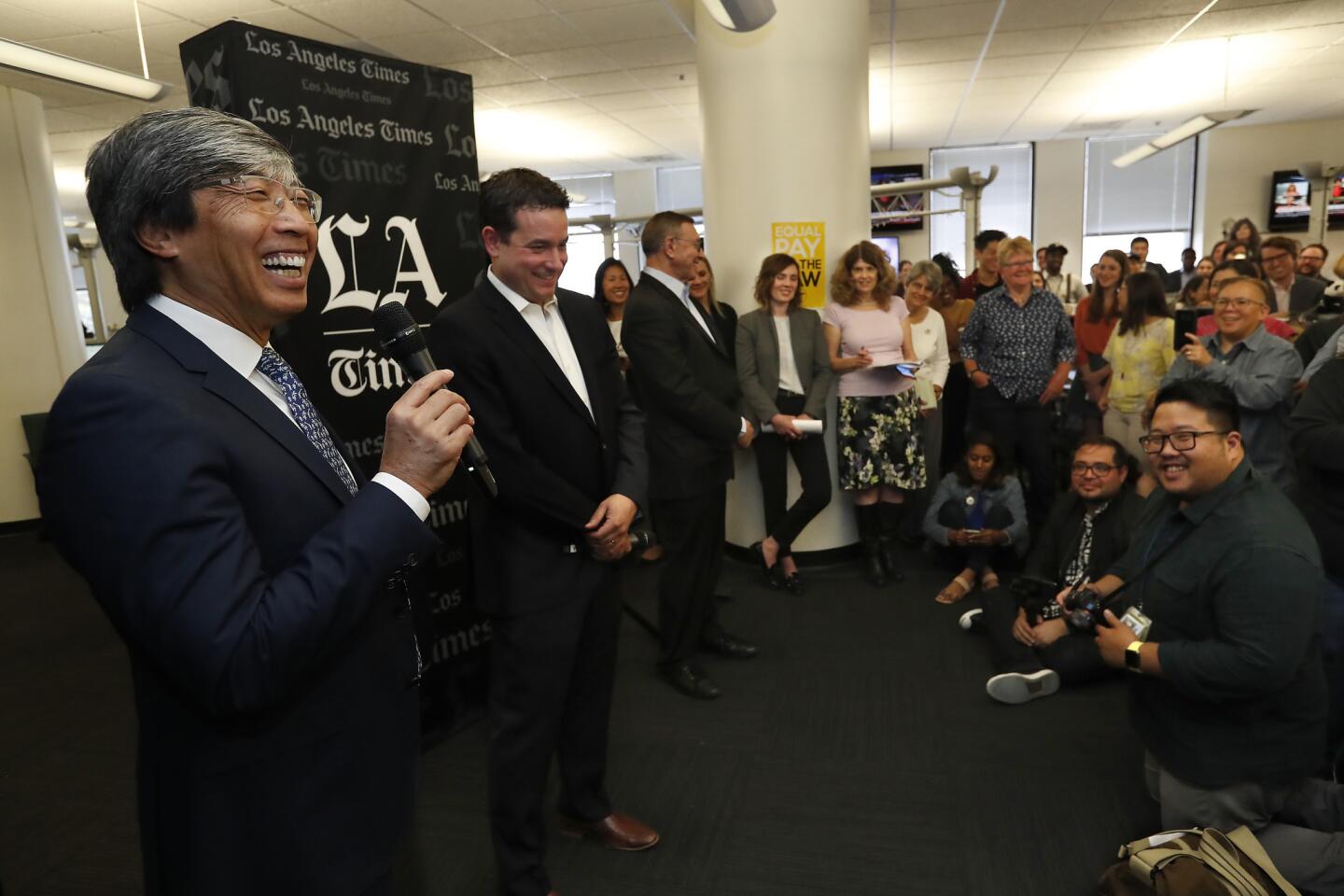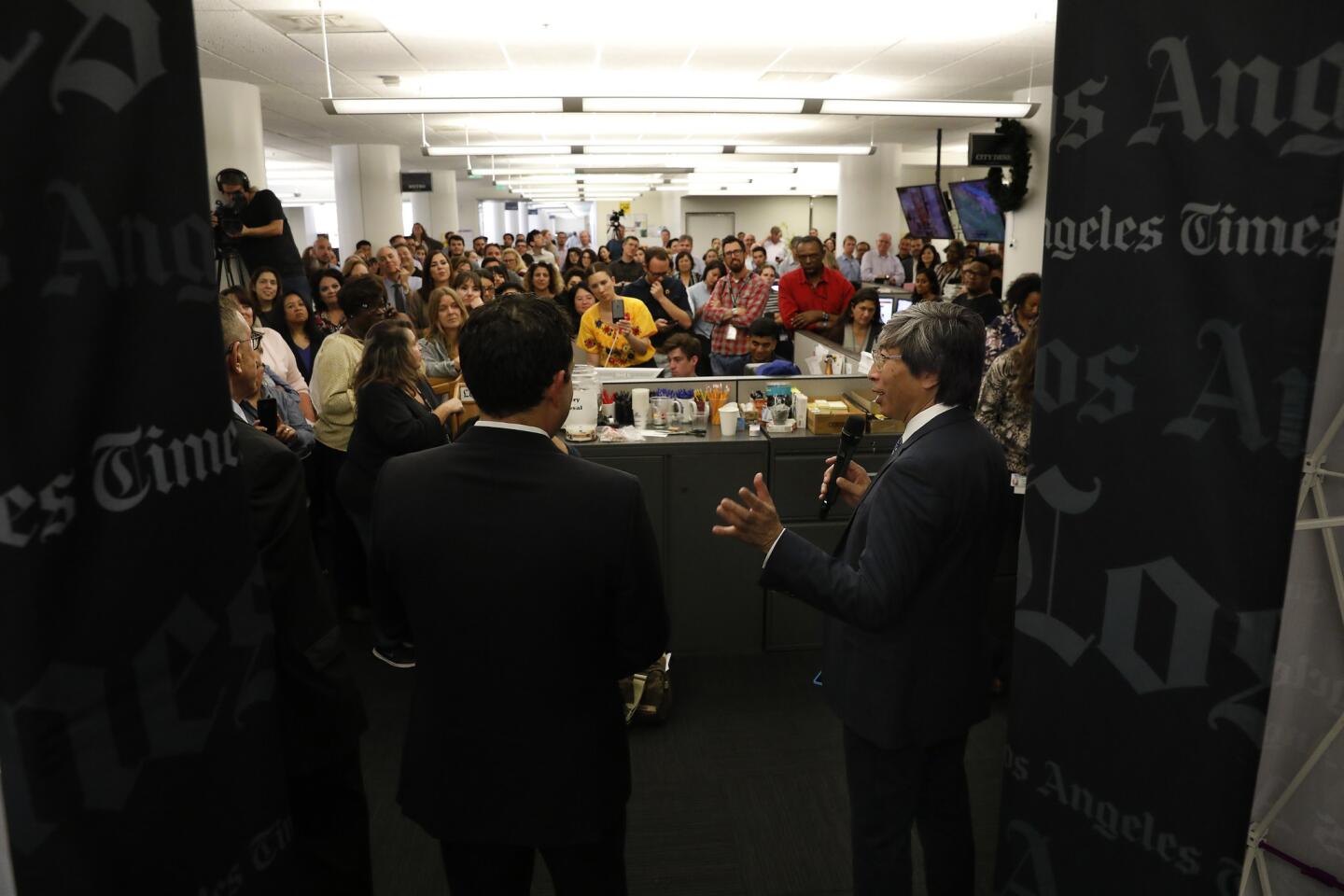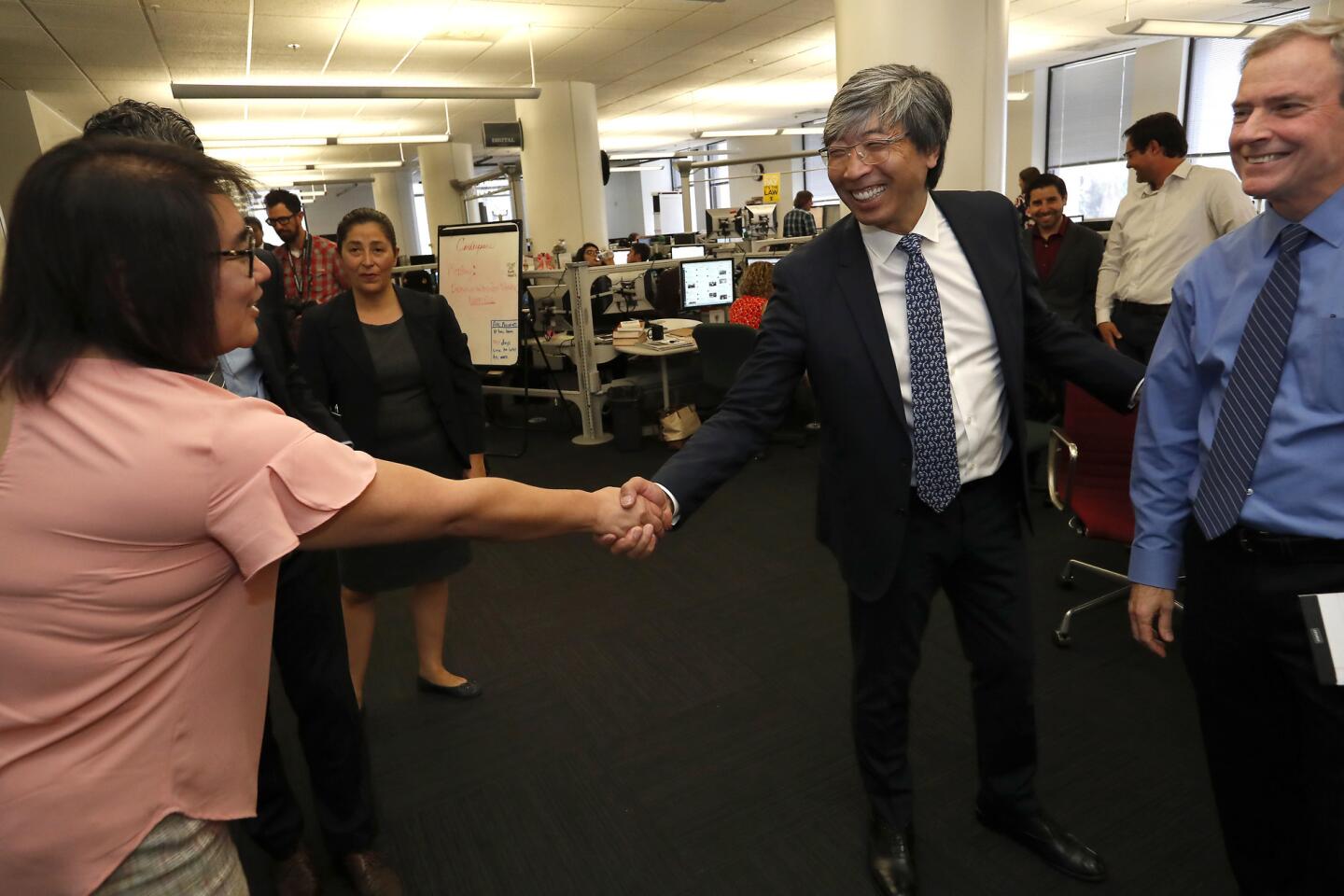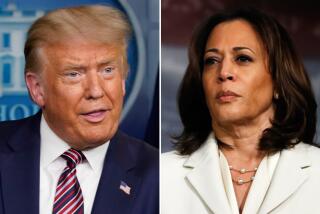New Los Angeles Times owner Patrick Soon-Shiong names veteran journalist Norman Pearlstine executive editor
- Share via
The Los Angeles Times has a new owner, a new editor and, after years of upheaval, a new path forward.
On the day that Dr. Patrick Soon-Shiong completed his $500-million purchase of the 136-year-old newspaper, the L.A. biotech billionaire announced he was naming veteran journalist Norman Pearlstine as its executive editor.
For the record:
12:00 p.m. June 18, 2018An earlier version of this story stated that I. Lewis Scooter Libby leaked information in connection to the Valerie Plame investigation. He was found guilty of multiple charges in connection with the investigation.
Pearlstine has spent 50 years in journalism helping shape some of the nation’s most prominent publications — including Time Inc. magazines, the Wall Street Journal, Bloomberg News and Forbes. It was the first major move by Soon-Shiong, who also bought the San Diego Union-Tribune, Spanish-language Hoy and several community papers from Chicago newspaper company Tronc.
During the last two months, Pearlstine, 75, has served as an advisor to Soon-Shiong, charged with creating a transition plan for The Times. He will now execute that plan.
“Not only does he have amazing experience with the full knowledge of how a newsroom runs — but he’s amazingly modern and forward-looking,” Soon-Shiong said. “There’s no agenda, other than to make this the best journalistic institution. We’re lucky to be able to capture him.”
Pearlstine becomes The Times’ fourth top editor in less than a year and its 18th since the paper began publishing in 1881. He succeeds Jim Kirk, a Chicago newsman whose nearly 10-month tenure came during a period of corporate dysfunction that culminated with the sale of The Times. Rather than accept a smaller role, Kirk decided to leave the paper.
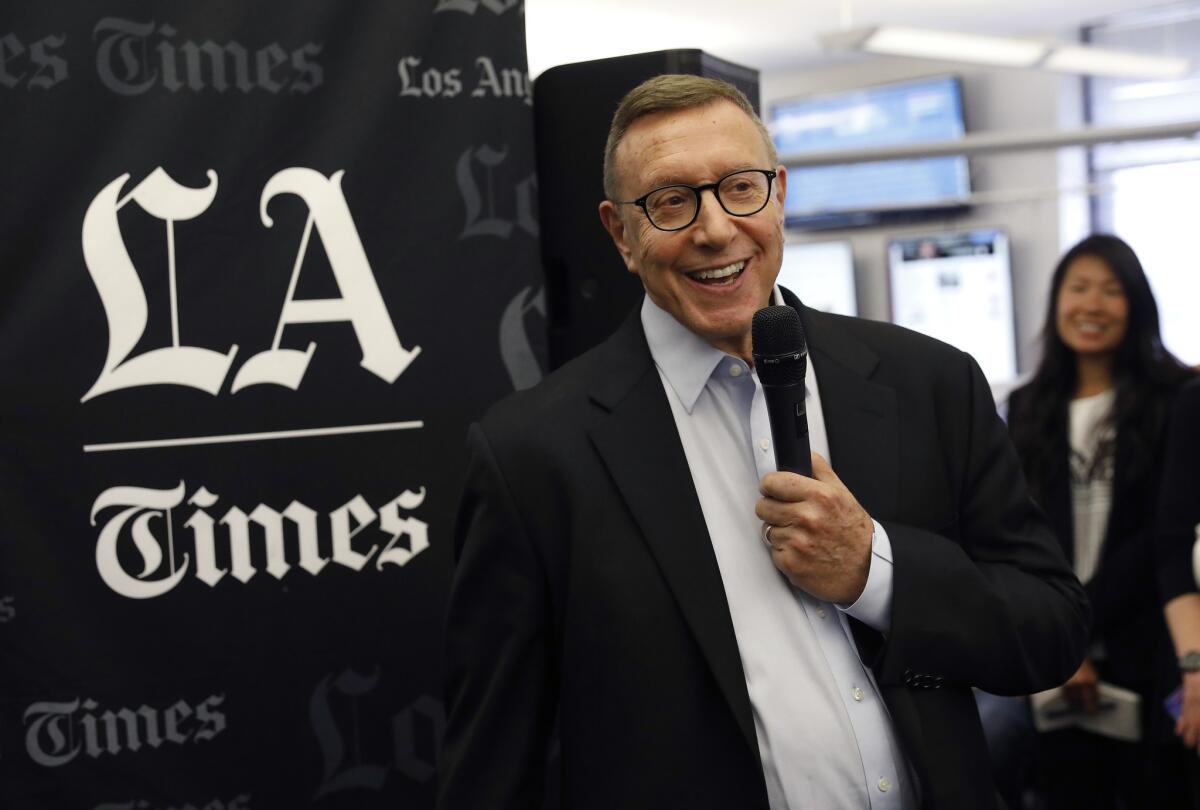
Soon-Shiong and Pearlstine were greeted Monday by a jubilant crowd of employees who squeezed into the center of the newsroom for an hourlong town hall meeting. There, the new leadership fielded questions and shared their vision for The Times.
“Let’s put Tronc in the trunk and we’re done,” Soon-Shiong said to cheers and applause.
“I can’t tell you how long I’ve wanted to work at the L.A. Times,” Pearlstine said, recalling how he had applied for a job decades earlier. “Thank you, Pat…. Better late than never.”
The change comes at a challenging time for print publications.
“We need to figure out the new business model,” Soon-Shiong said. “The interest of the reader is more important than the interest of the advertiser. That may be heresy because advertising still is the source of our revenue but it is a complex new dance in this new business model.”
Soon-Shiong, acknowledging his competitive nature, said he is determined to get The Times into the national conversation, which will require beefing up the newsroom.
Pearlstine told the staff that “it’s really on me” to come up with a staffing and hiring plan to present to Soon-Shiong. But he also has cautioned against trying to emulate other publications, saying: “It would be a huge mistake to try to be a clone of any East Coast paper.”
Pearlstine’s appointment came as a surprise to some, particularly because many figured he had retired after he left Time Inc. last year.
“I’m astonished — but not surprised,” said Walter Isaacson, a former Time magazine editor who now teaches at Tulane University. “This guy has a passion for journalism and an instinct for what’s interesting — and a true boyishness for making people realize that journalism is a noble profession.”
Marcus Brauchli, a former Washington Post editor who now runs investment firm North Base Media, agreed.
“The new owner could not have chosen a more stabilizing presence,” he said, noting that Pearlstine also will serve The Times well because he has spent the last few years getting immersed in the latest trends shaping digital media.
That’s how Pearlstine and Soon-Shiong met. In 2013, Pearlstine, then chief content officer of Time Inc., was intrigued by Soon-Shiong’s efforts to develop artificial intelligence that would make newspaper reading a more interactive experience. He flew to California to check out the work but it wasn’t ready to be deployed commercially.
After Soon-Shiong announced his purchase of The Times in February, Pearlstine quickly reached out and soon flew to Los Angeles for a meeting. He joined as a consultant in April, with marching orders to identify and recruit top editors.
Soon-Shiong has aimed high. He offered two L.A. Times alums — Marty Baron, executive editor of the Washington Post, and Dean Baquet, executive editor of the New York Times — the top job “knowing that it was a long shot.”
He even invited Baquet to his Brentwood home, which has a private basketball court. “I let him shoot a few shots to see if I could convince him,” Soon-Shiong said. “I said we’ll play HORSE and if I win, you’re gonna have to stay.”
Other top prospects were hesitant to join The Times with its revolving door of managers. “To anyone from the outside looking in, there has just been a lot of turmoil,” Pearlstine said, noting that part of his challenge is to prove “that the turmoil is behind us.”
Pearlstine advised Soon-Shiong against rushing one of his most important decisions.
“We thought that there was risk in trying to fill that job before we had a clear understanding of the staff … and a clear understanding of what the mission was,” Pearlstine said.
They discussed an interim role but quickly dismissed that idea.
“We’ve had enough interims,” Soon-Shiong said. “He’ll be here as long as he wants.”
Still, at 75, Pearlstine acknowledges that he might be in the job only a year or two.
“I’m realistic that one of the most important things I can do is to find my successor,” he said. “I think we will have a better idea of what the next generation of leadership is after we have done some more work and, frankly, after we have done some more listening.”
Soon-Shiong also announced that Chris Argentieri, currently the general manager of The Times, will become chief operating officer of California Times, the new corporate moniker for the group of publications that Soon-Shiong acquired. Jeffrey Light will remain publisher and editor of the San Diego Union-Tribune.
Although Monday was his first day on the job, Pearlstine in 2005 played a role in an effort to disentangle The Times from Tribune Co. He arranged a meeting between the late John Carroll, then the paper’s top editor, and Los Angeles power broker Eli Broad to see whether Broad would be interested in buying the paper. The billionaire philanthropist later joined investor Ron Burkle in a bid that was rejected.
The following year, Carroll gave a speech at an industry conference in which he provided a blueprint to save The Times. The key ingredients were local and private stewards.
“One of the great things that comes with Patrick’s ownership, with local ownership and a willingness to invest, is that it brings a period of stability,” Pearlstine said in an interview. “I’m lucky as hell to have this opportunity, and I feel confident that this is somewhere I think I can be helpful.… This remains an extraordinary place.”
One immediate task will be calming staff members, who since April have been worried about the looming move out of their historic Art Deco building in downtown Los Angeles, where the newspaper has been based since 1935.
The new headquarters in El Segundo will worsen the commutes for many, a hardship Soon-Shiong acknowledged. But he said The Times needs a modern home. He is developing a campus on 10 acres near Los Angeles International Airport, which will include an event center with an auditorium, a studio for podcasts and videos, and a museum on the history of The Times. He would like to host events, such as the paper’s annual Food Bowl and Festival of Books, there.
Pearlstine is energized by his new task. He has lost 50 pounds in the last year and has taken up boxing. He plans to find an apartment in the greater Los Angeles area, perhaps close to El Segundo.
He said his wife, Jane Boon, an industrial engineer, will divide her time between Los Angeles, New York and Vancouver, Canada. She is a native of Canada.
Pearlstine, who grew up in a small town outside Philadelphia, has been a fixture in New York media circles, where he is known for his intelligence, sharp wit and longevity in a business that tends to wear people out.
“He’s an absolutely first-rate journalist,” Brauchli said.
His long career has not been without controversy. In 2005, while serving as editor in chief of Time Inc., he was harshly criticized for turning over subpoenaed notes of reporter Matthew Cooper to a federal grand jury hearing evidence into the identification of Valerie Plame as a CIA agent. Pearlstine defended the action, saying that Time Inc. had spent millions of dollars fighting the special counsel in the matter and “lost every round.” The Supreme Court had refused to hear the case. Pearlstine later said that it was his most difficult decision in his career as an editor.
He started in journalism in 1967 as a copy boy at the New York Times, a few months after earning his law degree from the University of Pennsylvania. He moved to the Wall Street Journal in 1968, where he worked for the next decade, including a stint in Los Angeles and in Asia, where he launched the paper’s Asia edition. He became executive editor of Forbes magazine in 1978, a job he held for two years. But, in 1980, he returned to the Journal and served as managing editor from 1983 to 1991 and then as executive editor for a year.
After leaving the Journal in 1992, he worked to launch the magazine SmartMoney for Dow Jones & Co. and Hearst Corp. He became editor in chief at Time Inc. in 1995, overseeing such publications as Time, People, Fortune, Sports Illustrated, InStyle and Entertainment Weekly. That job brought him frequently to L.A. When he left in 2005, Time Inc. boasted more than 150 magazine titles.
He then spent five years as chief content officer for Bloomberg and served as chairman of Bloomberg Businessweek after the company acquired that magazine. He returned to Time Inc. in 2013 as chief content officer and was promoted to vice chairman in 2016. He retired last year as the company, reeling from a loss of subscribers and advertisers, prepared for a sale.
At The Times, Pearlstine will be looking to rebuild the newsroom and restore the organization’s reputation. He replaces Kirk, who came onboard last August, when Tronc sacked four top editors. Kirk led the newsroom until November, when Lewis D’Vorkin was brought in from Forbes.
D’Vorkin’s three-month tenure was disastrous, marked by clashes with staff and a vote by the newsroom to unionize, the first time in the paper’s 136 years. Tronc bounced D’Vorkin and, in late January, Kirk became editor in chief. About 10 days later, Tronc announced its deal to sell the California News Group to Soon-Shiong.
Tronc will soon return to its former name of Tribune Publishing, two people close to the company said Monday.
Pearlstine said he invited Kirk to stay in another capacity, but Kirk declined.
“It’s unfortunate but I understand that new ownership wants to go in a different direction,” Kirk said. “I’ve had a terrific but short run…. We’ve done some great work, I’m happy about that.”
The newsroom took on a party atmosphere throughout Monday. Midafternoon, more than 100 journalists toasted the newspaper’s new era in front of a banner with three crossed-out Tronc logos.
Amid the festive sounds of champagne bottles being uncorked, Pulitzer Prize winner and longtime Metro reporter Bettina Boxall described the paper’s nearly two-decade-long Chicago ownership as the “20-year war.”
“Here’s to the toughest newsroom in the whole business. Here’s to the Los Angeles Times,” Boxall said as the newsroom erupted in cheers.
UPDATES:
7:10 p.m. This article has been updated throughout with details from the town hall, afternoon celebration and additional interviews.
12:50 p.m.: This article was updated with news of Tronc’s name change back to Tribune.
This article was originally published at 11 a.m.
More to Read
Inside the business of entertainment
The Wide Shot brings you news, analysis and insights on everything from streaming wars to production — and what it all means for the future.
You may occasionally receive promotional content from the Los Angeles Times.
